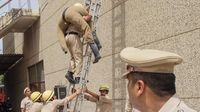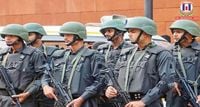New Delhi: Following a directive from the Centre, all states and Union Territories are gearing up for a large-scale civil defence drill on Tuesday, May 7, 2025. This exercise, which will unfold across 244 Civil Defence districts throughout India, aims to assess and enhance the readiness of both national and local civil defence mechanisms.
The impetus for this extensive drill comes in the wake of escalating tensions following the recent terror attack in Pahalgam, Jammu and Kashmir, which tragically claimed the lives of 26 civilians, most of whom were tourists. While the official communication from the Ministry of Home Affairs to the states’ chief secretaries does not explicitly mention Pakistan, the timing of this exercise has raised eyebrows. Analysts interpret it as a signal of India’s assertive stance amidst heightened security concerns, particularly after India’s suspension of the Indus Waters Treaty.
The last time such a nationwide civil defence exercise was conducted was during the build-up to the 1971 Indo-Pak war, a historical context that adds weight to the current scenario. The official notification indicates that the civil defence drill will reach down to the village level, involving coordinated efforts across multiple departments.
According to the Ministry, “The conduct of the exercise is planned up to the village level. This exercise aims to assess and enhance the readiness of Civil Defence mechanisms across all States and Union Territories.” Participants in the drill will include District Controllers, district administration officials, civil defence wardens and volunteers, as well as personnel from the Home Guard, including both active and reservist volunteers.
Moreover, youth organisations such as the National Cadet Corps (NCC), National Service Scheme (NSS), and Nehru Yuva Kendra Sangathan (NYKS), along with students from schools and colleges, will also play a crucial role in the simulation. The notification emphasizes the necessity for public preparedness, stating that civilians must be trained to respond to scenarios involving a “hostile attack.” Mock drills are expected to simulate various situations, including blackouts, evacuations, communication breakdowns, and emergency shelter setups.
As the nation braces for these drills, the Union Home Ministry has outlined a series of measures to be implemented during the exercise. This includes the operationalization of air raid warning sirens and training civilians on civil defence aspects to protect themselves in the event of a “hostile attack.” Other measures include provisions for crash blackout practices, early camouflaging of vital installations, and the rehearsal of updated evacuation plans.
In Punjab’s Ferozepur cantonment, a preliminary blackout exercise was conducted on May 4, 2025, where lights were switched off between 9 and 9:30 PM as part of the preparations. The local cantonment board had requested a power cut for this scheduled time, highlighting the urgency of ensuring preparedness amidst prevailing war threats.
Senior officials from the Delhi Police have also been proactive in response to the home ministry's directive. They have instructed all Deputy Commissioners of Police (DCPs) to prepare detailed plans for the upcoming mock drills. The DCPs have initiated meetings with senior police officers to bolster patrolling efforts across the national capital. “We have already increased day and night patrolling in the city. We have deployed paramilitary forces, along with police personnel, at Delhi’s borders with Haryana and Uttar Pradesh,” a source stated.
In light of the Pahalgam terror attack and the heightened threat perception across the country, police have undertaken robust security measures aimed at maintaining law and order and ensuring public safety. The DCPs are personally overseeing field-level deployments, coordinating with Assistant Commissioners of Police (ACPs) and Station House Officers (SHOs) to optimize resource utilization at the police station level.
To enhance vigilance, foot patrolling has been significantly increased, especially during evening and night hours. Special patrol units have been mobilized to cover key areas, ensuring a constant police presence in high-density locations such as Connaught Place, India Gate, and other vital installations. This enhanced presence is complemented by interactive policing, where beat officers engage with shopkeepers, commuters, and residents to address concerns and raise alertness.
During the mock drills, teams will also deploy the Bomb Disposal Squad (BDS) and dog squads to conduct anti-sabotage checks in high-footfall areas, such as Palika Bazaar and near government buildings. The police force is also conducting vehicle-checking drives and erecting multiple pickets at key access-control points to detect suspicious activity.
Prime Minister Narendra Modi has been closely monitoring the situation, holding a series of high-level meetings with top defence functionaries to deliberate on India’s response to the Pahalgam attack. Modi has made it clear that the government will pursue the perpetrators and those involved in the conspiracy to the “ends of the earth,” promising punishment that would be “beyond their imagination.”
This unprecedented civil defence drill is not merely a precautionary measure; it reflects a significant shift in India’s approach to national security. As the geopolitical landscape evolves, the government recognizes the need for comprehensive civil defence strategies to safeguard its citizens and infrastructure. The upcoming exercises on May 7 will serve as a critical test of the country’s preparedness to face potential threats.
In conclusion, as India prepares for these nationwide mock drills, the emphasis on civil defence readiness underscores the government’s commitment to ensuring public safety in an increasingly volatile environment. The drills will not only test the efficiency of emergency response systems but also foster a culture of preparedness among citizens, which is essential for national resilience against any potential threats.


